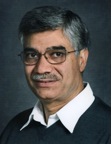
As the ALS Division Deputy for Scientific Support, I oversee the Scientific Support Group (SSG), with the help of deputies Eli Rotenberg and Michael Martin. The SSG’s primary mission is to support the efforts of researchers at the ALS through scientific and technical collaboration and scientific outreach. Depending on the needs of ALS users, the degree of collaboration can range from technical assistance with a beamline to full partnership in developing new research programs and experiment endstations. The SSG also strives to expand ALS scientific programs and broaden its user base through presentations, demonstration experiments, and publications.
The group organizes a variety of seminars, including a weekly ALS Center for X-Ray Optics (CXRO) x-ray science and technology seminar series: a targeted weekly lecture series with talks given by leading researchers on various topics. The SSG also organizes ALS Colloquia, given each quarter by world-renowned scientists in synchrotron research and related fields.
The ALS Doctoral Fellowship in Residence program, established in 2001, enables students to acquire hands-on scientific training and develop professional maturity for independent research. More details are available on the ALS Web site. In 2007, we initiated an ALS Postdoctoral Fellowship Program that identifies outstanding individuals in new and emerging scientific fields and provides them with advanced training. Both programs lead the way in establishing a pipeline of future beamline scientists to U.S. Department of Energy (DOE) Basic Energy Sciences (BES) user facilities.
The SSG played a very active role in creating the “Advanced Light Source Strategic Plan: 2009–2016, Addressing the Scientific Grand Challenges and Our Energy Future” and the new “Photon Science for Renewable Energy” brochure.
The SSG has pioneered unique techniques that enable novel science, particularly using soft x rays. Some of these are listed below:
- Development of ambient-pressure x-ray photoemission spectroscopy (APXPS) that enables XPS experiments at pressures of up to 10 torr, bridging a gap between ultrahigh vacuum and real-world industrial manufacturing conditions.
- Development of time-of-flight (TOF)–based electron-energy analyzers that provide unique advantages over diffusive analyzers. Recently, spin-resolved TOF achieved a world-record energy resolution of better than 20 meV.
- Development of an eight-pole electromagnet that allows unique experiments in x-ray magnetic linear dichroism, leading to reinterpretation of all prior results with this technique.
- Development of a new generation of both high-resolution and high-throughput (spectroscopes/spectrographs?) for photon-in/photon-out spectroscopy. Both of these perform orders of magnitude higher than previous generations.
- Achieved a spatial resolution of near 10 nm from a scanning transmission x-ray microscope.
The SSG has recently developed a new, higher-flux infrared beamline (Beamline 5.4), the meV-resolution beamline (MERLIN), and has begun construction of the MAESTRO beamline that will allow nano-ARPES studies.
I am very proud of the work done by the members of the SSG. They play a pivotal role in keeping ALS science at the forefront of its fields and making the ALS an outstanding user facility.